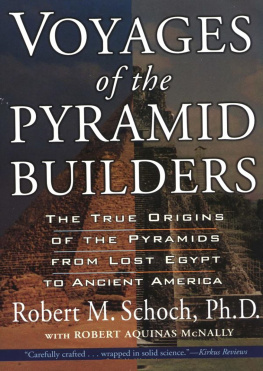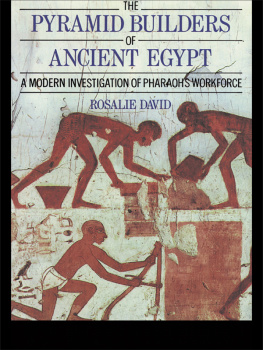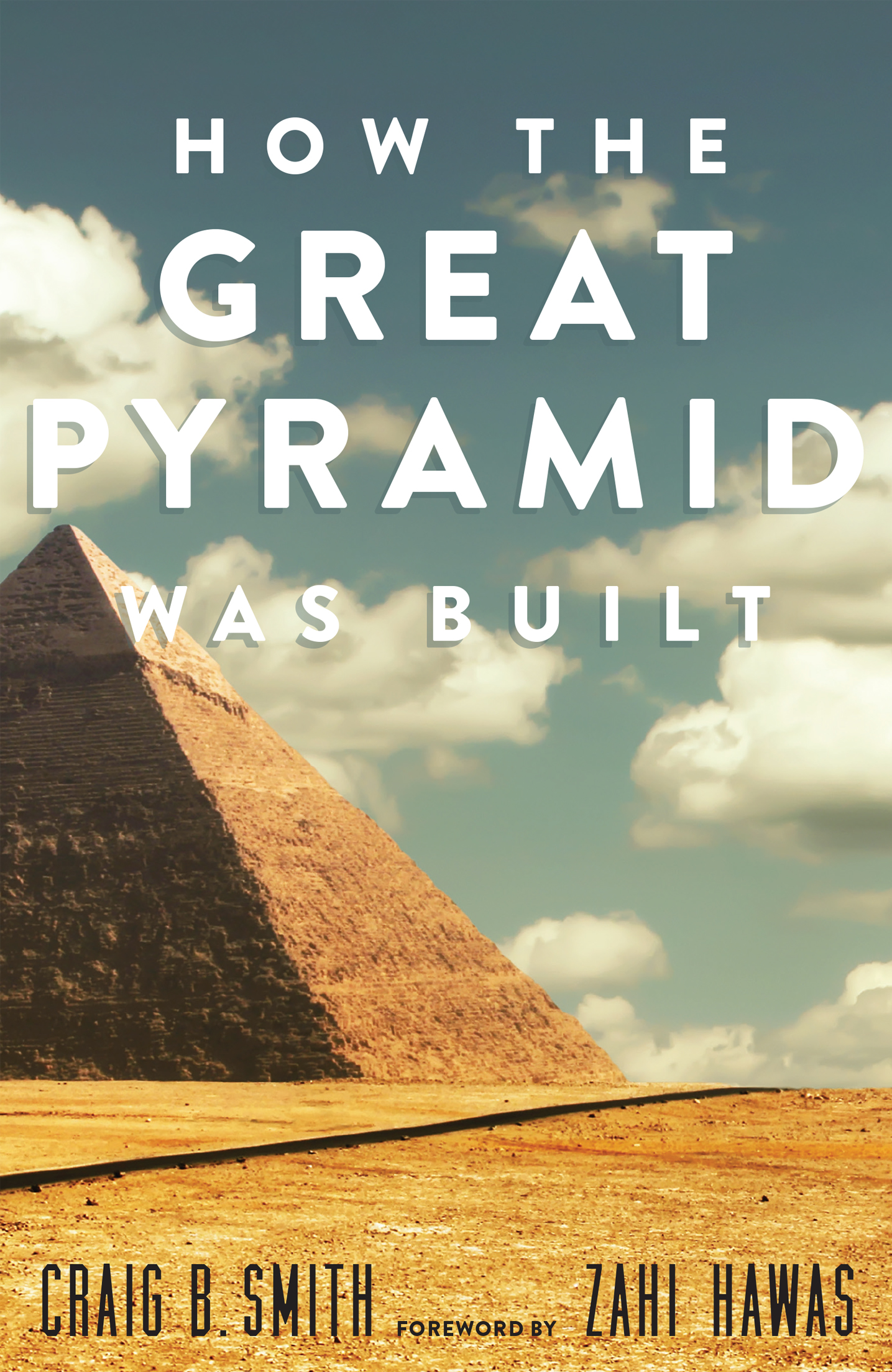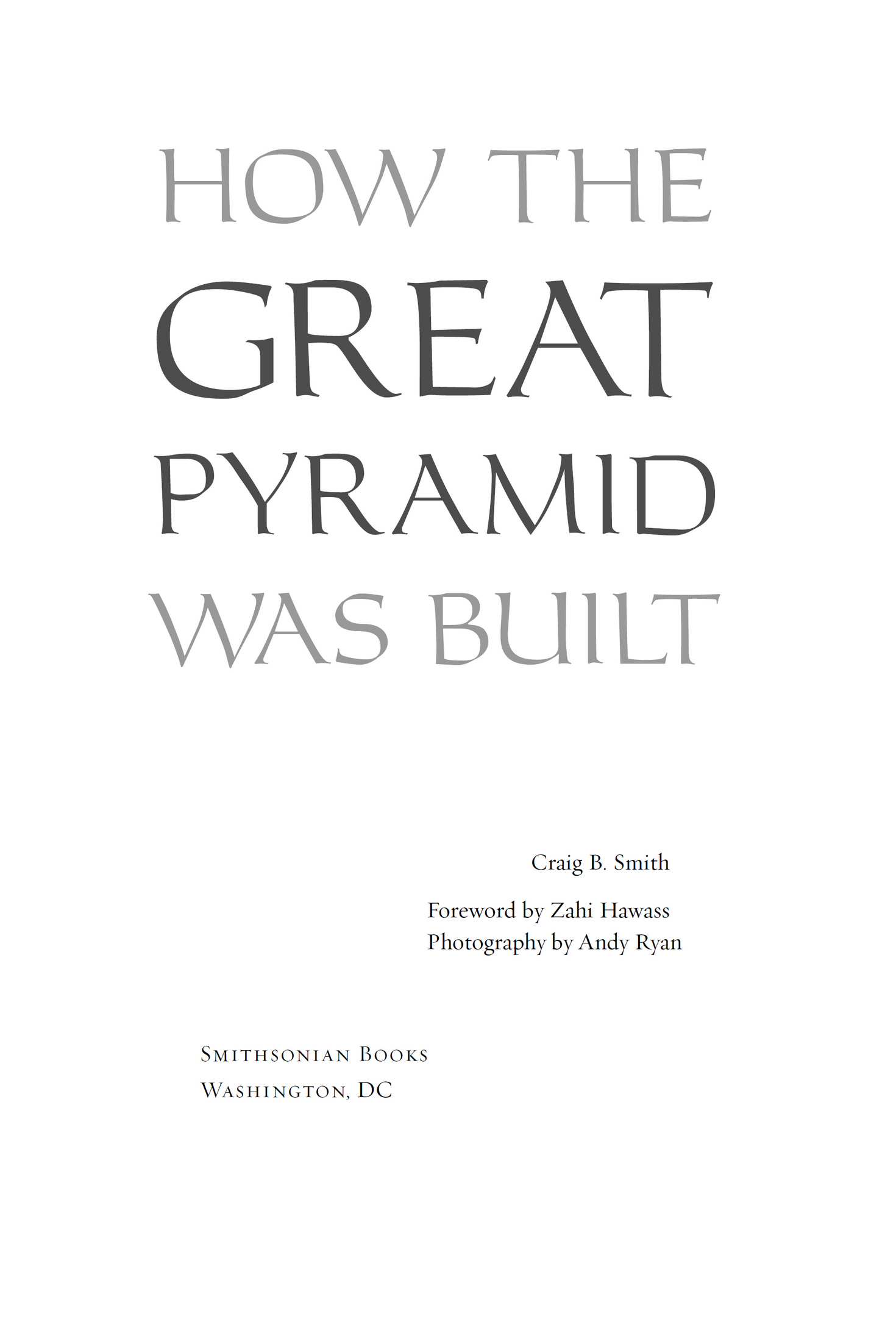2004 Craig B. Smith
Citing the company names DMJM, The Ralph M. Parsons Company, and Bechtel Corporation: Permission granted by each company.
Smith, Craig B.
How the Great Pyramid was built / Craig B. Smith; foreword by Zahi Hawass.
p. cm.
Includes bibliographical references and index.
ISBN 1-58834-200-X (cloth: alk. paper)
1. Great Pyramid (Egypt) 2. PyramidsEgyptDesign and construction. I. Title.
For permission to reproduce illustrations appearing in this book, please correspond directly with the owner of the works as listed in the . Smithsonian Books does not retain reproduction rights for these illustrations individually or maintain a file of addresses for photo sources.
FOREWORD
The pyramids have always captured our hearts. Magic and mystery surround them, filling scholars and the public with wonder that evokes the following question: How did our ancestors, 4,500 years ago, build these magnificent structures, and how did they organize the workforce that was necessary for their construction?
Our excavations in Giza have helped to shed some light on the mystery of the pyramids. We discovered the location of the quarry for the Great Pyramid of Khufu on the south side as well as the area of the ramps they used. We also learned how they constructed the base. The discovery of the tombs of the pyramid builders was a significant find that has provided us with important information about the workmen who dragged the stones, the artisans who sculpted statues and supervised construction of the pyramid base, the people who worked at the harbor, the overseer of the craftsmen, and the various people (overseer of the side of the pyramid, director of the draftsmen, overseer of masonry, director of workers, etc.) who were involved in the construction of the pyramids.
The sand and stones of Egypt hold the mystery of its past, and through our work it has been amazing and extremely rewarding to see some of these secrets revealed. Scholars always believed that the pyramid builders ate bread, garlic, and onion, but recent discoveries show that they slaughtered eleven cattle and thirty-three sheep and goats every day. They had enough meat to feed 10,000 workers a day. It is important to know that these young people, who worked from sunrise to sunset, were well fed.
The workers were organized into crews and then further divided into gangs. Each gang had an overseer. Every gang had a name such as Friends of Khufu. The gangs were divided into phyles (a Greek word meaning tribes). Each phyle consisted of 200 workmen and also had overseers. The phyles had such names as the Great Ones and the Green Ones. Each phyle was divided into units that consisted of about ten to twelve workers, and these units had such names as Perfection. I believe that the extensive organization involved in building the Great Pyramid is more important than the pyramid itself. We engineers, architects, and scholars could not succeed in building the Great Pyramid of Khufu today because we do not have the same dedication as the ancient Egyptians. The building of the pyramids was the national project of Egypt. Every household in Upper and Lower Egypt participated in the building of the kings pyramid by sending workforces, food, and supplies. They did this to help the king be a god; the pyramid was the ladder that the king would climb to the afterlife on his quest for immortality.
I used to teach a summer course at UCLA, and during that time my friend Elizabeth Brooks introduced me to Craig Smith. He was interested in the construction and management of building the pyramids. His background was in architecture and engineering, but he was as interested in the people who built the pyramids as he was in the engineering and construction. Elizabeth Brooks organized a conference on the pyramids at UCLA, and Craig Smiths lecture impressed me. He subsequently came to visit me in Egypt and conducted his own research, which entailed visiting many important sites, among them the tombs of the pyramid builders and our other archaeological sites at Giza.
How the Great Pyramid Was Built is a significant book for students, scholars, and the general public. The author explains the history and the development of the pyramids from the mastaba to the Step Pyramid to a true pyramid. Craig Smith was motivated to write this book because of his engineering background, and he has accomplished something quite remarkable. By looking at the Great Pyramid as a straightforward construction projectsomething never done before to this level of detailhe has independently confirmed what archaeologists have recently come to believe about the size of the workforce. The difference is, we couldnt prove it.
Through the years, many books have been written about pyramids. Scholars continue to excavate around the pyramids and publish their discoveries. Every discovery reveals more information about the pyramids and the incredible people who constructed them.
The mystery of the Great Pyramid of Khufu remains; however, we feel that we are making progress. In 1993 the so-called door (20 centimeters square), inside the south shaft of the so-called Queens Chamber, was found with two copper handles. Our exploration in September 2002 revealed another door behind the first and another in the northern shaft. We ask ourselves, Are these doors for symbolic use, for the king to reach the other world safely as a part of his quest for immortality, or are they hiding a great discovery? We hope to have our answers soon. We will continue to explore, excavate, and research until we reveal all the mysteries of the Great Pyramid of Khufu.
Zahi Hawass
Dr. Hawass is the secretary general of the Supreme Council of Antiquities and the director of excavations at Giza, Saqqara, and Bahariya Oasis.
AUTHORS NOTE
A few words about the preparation of this book are in order. First, I am not an archaeologist. Ive drawn heavily on the knowledge and expertise of two leading authoritiesZahi Hawass and Mark Lehnerfor anything related to archaeology. They are considered among the best in their field. My interest lies in the engineering and construction of the Great Pyramid, and that coincides with my own experience and expertise. Since a substantial part of the pyramid is still standingalbeit in a slightly damaged conditionit is possible to examine the construction and determine how some tasks were undertaken and executed. The same is true of the architecture and engineering design.
This type of forensic analysis can only be carried so far, however; then one encounters a gap in solid information and findings. I decided to investigate this gap with the modern tools available to someone who plans and manages large public works projects. By means of this approach, bits and pieces of factual data can be assembled, and models can be developed that lead to a reasonably good understanding of how the project was implemented. Certain assumptions must also be madefor example, how many loads of soil or sand could an ancient Egyptian laborer haul per day? Fortunately, these things can be estimated with a good degree of accuracy. When we are less certain, a technique called sensitivity analysis can be used to check how sensitive the final result is to the analysis. If large changes in the estimate do not change the final outcome, then the model is said to be insensitive to that particular parameter. For example, if the labor in hauling soil and sand was only 2 percent of the labor involved in cutting and finishing blocks of limestone, then it wouldnt matter very much if we were off by 10 percent or even 50 percent in our estimate of sand-hauling labor. I endeavored to make these analyses as I checked the data and the assumptions I used.





